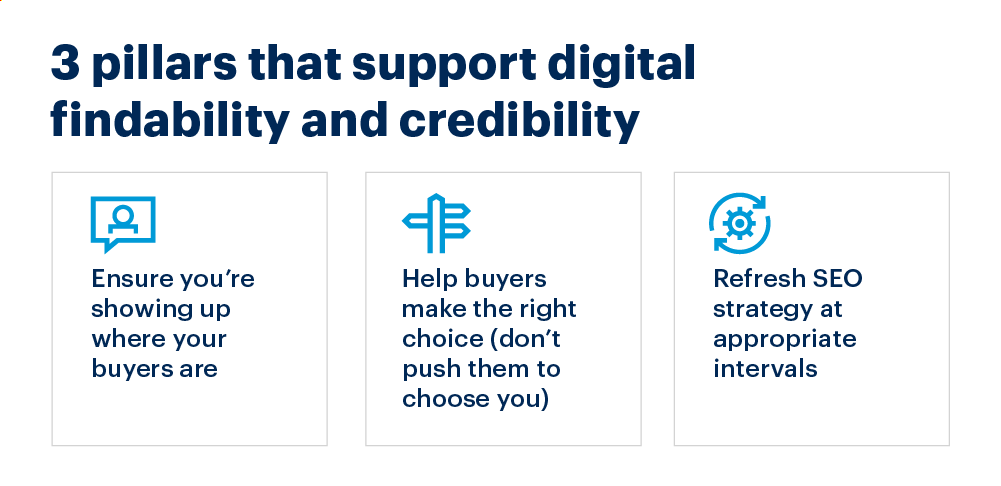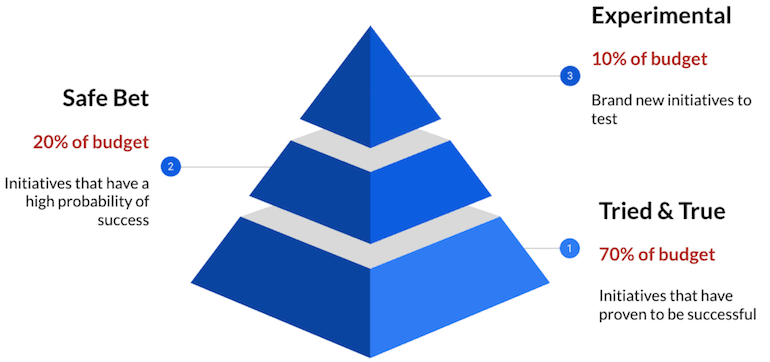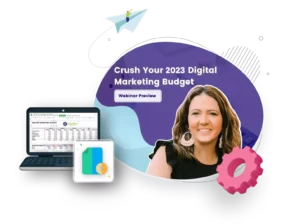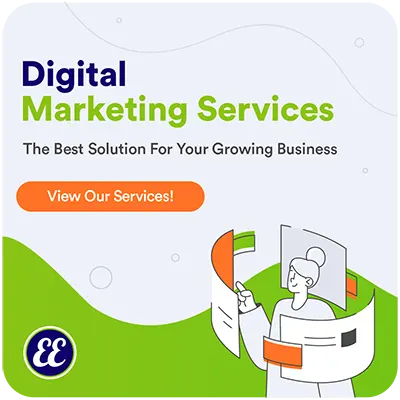Are you working on creating a marketing budget for 2023? You may be wondering about how to start the planning process.
Marketing budgets don’t have to be complex, but they do require some planning.
Don’t know where to start? Kick off your 2023 budgeting process with our free Strategic Marketing Budget Template, containing 8 Google Sheets filled with lists of budget items you lean on to create your own custom marketing budget.

Get Your 2023 Strategic
Digital Marketing Budget Template
Free Download!
By starting the planning process now, you’ll be able to better plan for the upcoming year and ensure that your marketing efforts are driving the best results possible.
Good on you for thinking ahead!
When it comes to planning a marketing budget, many companies make the mistake of focusing their efforts on the short term. As a result, the company isn’t able to accomplish what it needs to over the long term.
This is why you need to be strategic when it comes to your marketing budget! Creating an effective, data-driven budget starts with having an idea of what marketing strategy you want to implement.
Below, we provide an overview of how to create a strategic marketing budget that’s tailored to your business’s goals and areas of opportunity.
We’ve put together 9 simple steps for creating your 2023 marketing budget (and we’ve also thrown in some valuable industry tips!). Ready to get planning?
1. Sit Down, Turn off Distractions, and Reflect
When it comes time to start putting together your budget for the next year, your first instinct is to probably start budgeting right away — maybe even just copying some of last year’s budget.
Don’t do it this way. Instead of jumping right in, take some time to step back and reflect on your company as a whole.
Smarter budgeting starts with you recognizing what areas of your business actually need your dollars — not just the areas that usually get your dollars.
While you’re in this first stage of reflecting, ask yourself: “Does my business have a brand story or a clear value proposition?”
You’d be surprised by the return on a strong brand story and value proposition. If it’s clear that both of these areas could use some love, recognize that you need to allow some additional dollars to these initiatives.
Invite Input from Others
And you also want to give the floor to important voices across your business (including your marketing team and your leadership team) during this reflection stage.
Invite everyone in your marketing team to a mid-Q4 planning meeting and ask them what they think the team could be doing better/should start doing. You can also prompt conversation by asking the team to share the 3 things they think they should stop doing.
Virtual Workshop by Ellison Ellery Marketing and Growth Agency

“Uncovering Your True Brand Story”
We’ll host a customized one-on-one brand messaging workshop so your business can get clarity on what it does, how it does it, and what pain points it’s solving for. The workshop is one portion of your deliverable. We also take what we heard in the workshop and then apply that to write your mission statement, vision statement, and a few one-liners for your business. You’ll have everything you need to have a clear vision of how your product and service benefits your buyers.
Virtual workshop 3-4 hours (Additional hours included in price for creating a Summary Memo.)
Hearing the perspectives of multiple key players in your agency can help you to reallocate your dollars in a powerful way. Understanding the real challenges and desires of people across your company can help you to budget for what’s actually needed for your business to start making real headway.
Remember: budgeting isn’t just about managing your company’s money — it’s strategizing how your money can start working for you.
2. Plan for Major Events

Your business’s upcoming major events will be foundational blocks of your budget.
So what are major events? These can include anything from brand refreshes and website redesigns to product launches and live events.
And, if you make the time to take a step back and reflect (Step #1!) first, you may find that you will have to allocate more of your budget to major “events,” like brand refresh, if your brand story and value proposition could use some clarification and re-working.
Your business’s major events are non-negotiable — they’re what’s driving your business forward. That’s why it’s important to factor them into your budget earlier on so that more inconsequential items in your budget don’t “steal” from them.
3. Adjust for the Changes in Your Buyers’ Behavior
Did you know that, in 2025, 80% of the sales cycle will happen in digital or remote settings?
This means your buyers are ready to purchase by the time they schedule a demo with you. So, you need to focus on getting more people wanting to learn about your product or service in the awareness stage.
That’s why your website needs to carry the burden of selling more than ever before.
People may come to your website and then decide that what you have isn’t interesting enough or applicable to them — so they end up leaving.
This can happen for several reasons:
- your message isn’t clear enough
- your site takes too long to load
- your design isn’t attractive
- you have poor usability
- and more.
It’s important you (1) understand that business has shifted greatly into a more virtual environment and (2) recognize the implications this has for your “new” buyer’s journey so you can plan accordingly for 2023.
How to Allocate Budget for Digital Marketing

Since your buyers’ digital experiences with your business will be one of the biggest factors in their commitment to buy/not buy, you need to consider allocating more of your budget to your online presence.
Here’s a few considerations to get you started:
Information Technology (IT)
Having IT resources on hand is a must if you are planning to do a website redesign. Even if you aren’t planning on doing a website redesign in 2023, having reliable IT at your disposal is crucial so you can work through any technical site issues when they arise ― and they will arise.
MarTech
Marketing technology is the single largest area of investment for marketers. The top MarTech priorities for marketers are usually (1) email marketing platforms, (2) web content management, and (3) digital marketing analytics platforms. MarTech can simplify your processes and provide valuable insights, making this category a non-negotiable for successful digital marketing.
Conversion Rate Optimization (CRO)
Ensuring your online presence is as effective as it can be takes patience, processes, and money. In 2023, consider putting more dollars into CRO. By testing your landing pages, messaging, keywords, images, CTAs, and more, you will understand what resonates the best with your prospective buyers and increase revenue.
To get a full list of budget items, download our Strategic Marketing Budget Template.
4. Solve Your Marketing Operations’ Biggest Challenges
Your business and/or marketing department probably has one or two big challenges that you just never seem to be able to figure out. And that’s okay!
Instead of doing the same things over and over again, hoping that one day it’ll finally bring you more leads and sales, now is the time to rethink how you are approaching your biggest challenges.
You should cut out the things that aren’t working at all to make room for more effective initiatives, and clean up the things that could work but you just can’t seem to figure out.
And make sure that you aren’t pushing more spend to something that “everyone else is doing.” If it’s eating your resources and isn’t driving results, cut it!
Start strategically allocating more of your budget to your biggest solvable challenges.
Most Marketers’ Biggest Challenge
According to HubSpot, 61% of marketers rank lead generation as their number one challenge. This can be a huge pain point for marketers.
53% of marketers say half or more of their budget is allocated to lead generation (The Hubart Group), but 79% of marketing leads never convert into sales! (Marketing Sherpa).
Crazy, but true.
And most marketers find that outbound tactics don’t provide a higher number of quality leads.
So, what do you do? It depends.
Lead volumes and quality can vary greatly depending on your industry, niche, and specific marketing approach.
So, if lead generation is one of your biggest problems too, here’s 3 solutions to generating more high quality leads:
Content Marketing
Content Marketing is 62% more cost-effective and generates 3x more leads than outbound marketing.
Video Content
Strong video content (supported by your budget!) is more effective when it comes to converting users to qualified leads.
Targeted Emails
Timely lead-nurturing emails get 4-10x the response rate compared to standalone cold pitches. And leads are 9x more likely to convert when businesses follow up within 5 minutes!
5. Be Strategic, Not Tactical

The best properties to buy in Monopoly are the Oranges (New York Avenue, Tennessee Avenue, and St. James Place) because they are landed on often and they have the highest ROI.
To win, advanced players strategize by not only purchasing advantageous properties early but also by creating relationships with the other players to get their hands on the best properties.
On the other hand, buying the cheapest properties (or, even worse, any/every property as you can) is one tactic that may look like a good idea at first glance but will ensure your defeat.
Budgeting for digital marketing while focusing on tactics looks like this:
✖ “We need X amount for paid social media, X amount for production costs, and X amount for software.”
However, a marketing budget strategy is a much more robust plan and should look more like this:
✔ “Become the No. 1 educational platform for discerning professionals when they burn out and are looking for a new career. Deliver a tailor-made omni-channel experience. Push for efficient product trial and on-page conversion rates by developing ecosystems based on onboarding and customer success touch points.”
That’s why you need to align your budget to your strategy — not the other way around.
A marketing budget strategy should integrate many internal and external factors, but here are three core elements you can follow:
- A good marketing budget strategy should focus on one core value about your brand, your market, or, most importantly, your consumer.
- A good marketing budget strategy should focus on your brand positioning and its promise to customers.
- A good marketing budget strategy should focus on building relationships with your consumers.
Make sure that your budget backs up your strategy so you’re not just throwing money at what “sounds” like a good idea.
6. Decide on the Right Channels for Your Business
Not all promotional channels are going to drive results for your business — variables like your industry and niche can make some channels better (or worse) than others.
The channels you choose for your marketing strategy should be tailored to your company!
Not sure how to decide which channels are right for your business? Get started by asking yourself these questions:
- Do we need to do outreach?
- Is this an inbound marketing strategy?
- Do I want to target specific audience groups based on their demographics? (e.g. job, title, age, etc.)
- Is it better to target a specific audience group based on intent and behaviors?
- Is my goal awareness? (i.e. tracking views and traffic)
- Is my goal conversion? (i.e. tracking qualifying activities)
After asking these questions, you’ll be a step closer to determining which channels will drive the best results for your business’s goals. Budgeting is all about putting the right amount of money in the right places!

The Top Digital Marketing Channels
Here’s a list of some of the most popular digital marketing channels marketers are using today to attract more leads online.
And, remember! These are not “one size fits all.” Nail down your business’s goals first and then match up the right digital marketing channels:
Websites
- Content marketing
- Increased organic traffic
- Lead Generation
- Brand awareness and conversion
- ROI
- Lead nurturing
Social Media
- Customer engagement
- Broader audience reach
SEO (Organic Search)
- Search rankings
- Link building
Paid Search (SEM)
- Brand awareness
- Lead generation and conversions
Mobile
- Increase in sales
- Creating demand
- Brand accessibility
Display Ads
- Brand awareness
- Sales and conversion
Affiliate Marketing
- Wider market reach
- Qualified sales leads
Video Marketing
- Audience engagement
- Increased reach
- SEO boost
7. Use the 70/20/10 Rule on your marketing budget
The amount you spend is not as important as how you spend it.
It is entirely understandable to be fairly hesitant when it comes to relinquishing money, especially if it means handing it over to outside agencies who decide where it gets spent.
There will never be enough resources to engage in every initiative or campaign — that’s why it’s imperative that CEOs ensure that their finite dollars are funneled into programs that produce maximum returns on your marketing budget.
Looking to simplify the spending categories in your marketing budget ? Check out the 70/20/10 Rule:

70%
70 percent goes toward what you’ve already quantified as “effective marketing.” Did radio and television ads bring in sales? Make more! Did social media contests win you a landslide of customers? Double down on those!
The thing here is to not spend 100% of your money on these winners despite the understandable urge to do so. Don’t put all your eggs in one basket.
20%
20 percent of your budget needs to go toward newer, more creative ways to attract and engage with your consumer base and reach untapped segments — especially in areas where your competitors might be gaining traction. You want to already be there when they arrive.
Examples might include carving out new paths in untapped social channels or repurposing content in new creative ways. So — what about the last 10%?
10%
10 percent of your marketing budget should be reserved for fun, innovative, cutting-edge concepts and approaches — with zero expectations. At best, you’ll be seen as an early adopter, attract the attention of other early adopters, and potentially win new business. At worst, some of this 10% may end up as (take a deep breath) a loss. Remember when we said you won’t know until you try? Well, not everything will succeed, and that’s okay.
Final thought here: just because something didn’t work recently doesn’t mean it will never work. If you really believe in an idea that failed, toss it back up into the 20% bucket and rework it. That’s precisely what that category is for! 🙂
8. Keep Your Marketing Budget Flexible and Stay Open-Minded.
Generally, the people in charge of large budgets are risk averse people. They are the people who double knot their shoes, look both ways before crossing the street, and drive the exact speed limit.
That’s why the marketing budget looks so similar year in and year out.
However, think: when are any two years in the digital marketing world alike? Trends change, best practices change, social media channels emerge out of nowhere, and more — it’s unpredictable and requires constant readjustment.
And, most importantly, buyer behavior changes. That’s why businesses need to aggressively invest in what works now and take a calculated risk.
A great example is SEO services — companies will decide on their budget in this area a bit arbitrarily.
For example, we see companies say they want to spend $5,000 a month on SEO and content marketing.
What if you could unlock more growth if you threw more money at SEO?
It’s important to understand what drives leads and sales and it’s also important to evaluate what will actually drive more results if you devote more money to it.
Does the keyword search volume support your hypothesis? Can you do more link building or a campaign to get more referrals on G2?
What if you spent $15k for the next three months to accelerate your results!
Do the research on which channels are producing results for your competitors and aggressively invest in yourself.
9. Be Data-Informed with Your Marketing Budgets
Being “data-informed” about your marketing budgets doesn’t have to be complicated.
Use this simple rule of thumb: Allocate More to Efforts With Proven Results.
Here is a paid media example:
If you poured $10,000 into Facebook Ads last month and saw no clicks, conversion, or attributable revenue, does it make sense to run those same ads with the same budget this quarter?
No. No, it doesn’t.
The first thing you will want to do is immediately pause your campaigns and analyze the data.
That’s why it’s crucial to continuously review the performance of your marketing collateral and activities as they pertain to budget so that you allocate your funds appropriately. In other words, pouring gasoline won’t grow your fire until you already have a flame.
Some questions you should ask yourself during this review are:
- What marketing activities contributed to our bottom line?
- Does it make sense to maintain or grow the budget in these areas?
- What marketing activities did not contribute to our bottom line, or at least as much as we had hoped?
- Is there anything we can change about these ads or campaigns that could improve their performance?
- Which channels’ or initiatives’ performance improved or worsened over time?
- For those that improved, how can we continue this trajectory?
- For those that got worse, is there anything we can do to reverse course, and is it worth it to attempt to reverse course?
All in all your marketing budget will be a “living” plan. Since marketing, technology, and user behavior is always changing, so will your marketing priorities. That is why it is always important to have a second pair of eyes reviewing your work.

Budgeting for Marketing Doesn’t Have to be a Headache
At the end of the day, a marketing budget is very simple and it doesn’t have to feel overwhelming. Even a tight budget shouldn’t stop you from successfully executing your plans and seeing exciting growth!
Feeling in control of and confident about all of the choices that have contributed to your 2023 marketing budget is the key to having a stress-free budgeting experience.
Understanding where your money is going helps you understand how your business operates as a whole. That’s why “budgeting season” provides an amazing opportunity to refocus on what is most important.
And we know that running your daily business operations and your marketing at the same time is challenging.
Ellison Ellery provides the expertise of a full marketing team for your business so you don’t need to hire more staff.
Learn more about how Ellison Ellery can help your business strategize for growth!











